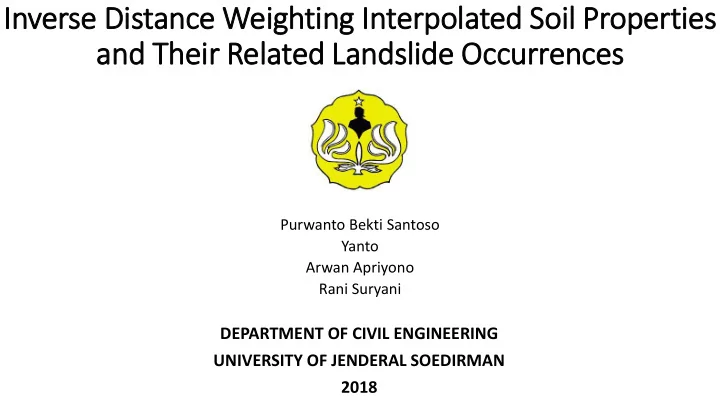

In Inverse Distance Weighting In Interpolated Soil Properties and Their Related Landslide Occurrences Purwanto Bekti Santoso Yanto Arwan Apriyono Rani Suryani DEPARTMENT OF CIVIL ENGINEERING UNIVERSITY OF JENDERAL SOEDIRMAN 2018
Background Landuse (vegetation) Topographic, terrain slope LANDSLIDE Rock and soil properties Climate (hydrologic) Earthquake
Background • Works on identifying approximate regions of potential landslide risk were mostly based on topographic and hydrologic condition, i.e. by overlaying parameters of topography, geology, land use, and climate. Each of which was scored to represent its effect on landslide. • Landslide is caused by instability of slope, therefore identification approximate regions of potential landslide risk should be based on slope stability factor. • Slope stability requires calculations of the driving forces (gravitational forces due to weight of soil and water, and other overburden loads) and the resistive forces (soil shear strength) . • Soil shear strength depends on soil properties . • Soil properties data are not always available at locations of interest. • A method of interpolation is necessary to approximate soil properties at location of interest.
Purpose • Interpolate scattered soil properties data using Inverse Distance Weighting (IDW) method to get evenly spatial distribution of soil properties. • Relate interpolated soil properties with landslide occurrences.
Location of Study Western part of Central Java: Wonosobo, Temanggung, Kebumen, Study area Banjarnegara, Purbalingga, Banyumas, Cilacap, Brebes, Tegal, Pekalongan and Pemalang
Frame of f study Current Study Soil Location of Landslide Properties Occurences Interpolation (IDW, Kriging, Co-Kriging) Map of interpolated Soil Properties Slope Stability Analysis Slope Stability Approximate Regions of Potential Index Landslide Risk
Inverse Distance Weighting (IDW) Method The IDW formulation is Where: : interpolation target value : known value at location i : distance between the target and the known value at location i : weighting factor : number of known data considered in the interpolation
Data and parameter for the interpolation • Data were collected from 336 sites over the years of 2005, 2006, 2007, 2010, 2011, 2012, 2013, 2014, 2015 and 2016. • Depths of hardrock : 336 data • Soil cohesion : 226 data • Internal friction angle : 228 data • the distance between the target and the known value was calculated based on location coordinates • the weighting factors used in the interpolation were = 1,2,3.
Validation • validation of the interpolation makes use of the percent bias • q ukur and q inter represent measured and interpolated value. • The data were randomly splitted so that 15% data was the target of validation, and 85% data was interpolated. • There were 10 interpolation trials per weighting factor, each of which was evaluated according to its percent bias.
Spatial distribution of Depths of hardrock Depth of hardrock or bedrock (m)
Spatial distribution of Soil Cohesions Soil cohesion (kg/m 2 )
Spatial distribution of internal friction angle Internal friction angle ( 0 )
Weighting factor effect on percent bias (depths of hardrock interpolation) Averaged: α = 1 → -103,118% α = 2 → -135,308% α = 3 → -154,557% Percent bias (%) IDW trials
Map of interpolated depths of hardrock
Weighting factor effect on percent bias (soil cohesion interpolation) Averaged: α = 1 → -149,427% α = 2 → -173,718% α = 3 → -180,672% Percent bias (%) IDW trials
Map of interpolated soil cohesion data
Weighting factor effect on percent bias (interpolation of internal friction angle) Averaged: α = 1 → -34,844% α = 2 → -32,556% α = 3 → -7,488% Percent bias (%) IDW trials
Map of interpolated internal friction angle data
Interpolated Hardrock Depths and Their Related Landslide Occurences Hardrock depth (m) Weighting factor 2 – 4 4 – 6 6 – 8 8 – 10 10 – 12 12 – 14 α = 1 - 1 52 10 1 - α = 2 1 12 29 18 2 2 α = 3 8 12 21 15 1 7
Interpolated Soil Cohesions and Their Related Landslide Occurences soil cohesion (kg/cm 2 ) Weighting factor 0.0 – 0.2 0.2 – 0.4 0.4 – 0.6 0.6 – 0.8 0.8 - 1 1- 1.2 α = 1 2 61 - 1 - - α = 2 28 32 - 2 2 - α = 3 36 22 3 2 - 1
Interpolated Internal Friction Angle and Their Related Landslide Occurences internal friction angle ( 0 ) Weighting factor 10 – 20 20 – 30 30 – 40 40 – 50 10 – 20 20 – 30 α = 1 - 29 35 - - 29 α = 2 1 18 43 2 1 18 α = 3 1 16 37 10 1 16
CONCLUSION • Concerning the percent bias, The validities of resulted spatial distributions were varies according to selection of weighting factor. • IDW interpolation using higher weighting factor corresponds with higher percent bias in case of depth of hardrock and soil cohesion, while oppositely found in case of the internal friction angle . • Validation to landslide incident in western part of Central Java Province shows that the majority of landslide incident occurs at depths of hardrock of 6 m - 8 m, at soil cohesion of 0.0 kg/cm 2 – 0.2 kg/cm 2 , and at internal friction angle of 30 0 - 40 0 .
Recommend
More recommend